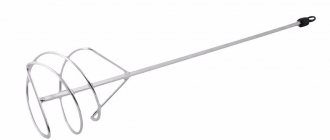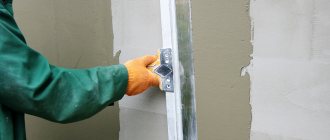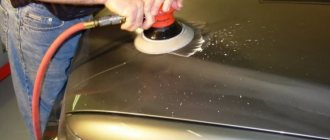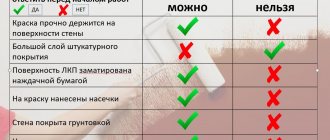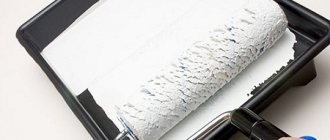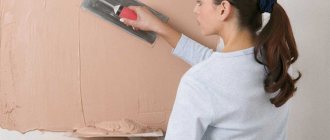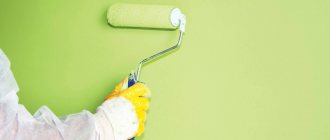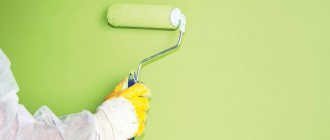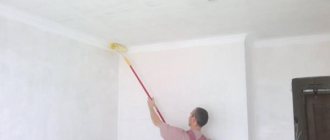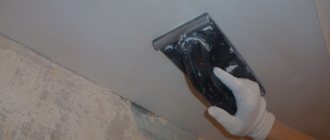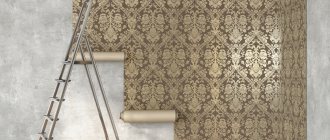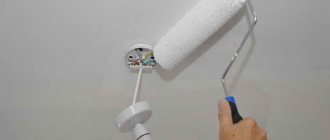In old-type buildings, it is quite common to find painted ceilings and walls. When renovating, many people ask the question: is it possible to putty over paint? How justified will the efforts be, or is it better to completely remove the old surface? To perform high-quality repairs, you need to take your time and adhere to some of the recommendations presented in this article.
A professional worker, when asked whether it is possible to apply putty over paint, will answer that it is better not to do this. At the same time, quite often removing the old coating is very problematic or almost impossible. Therefore, ways to solve the problem have been invented that will allow the putty to be applied to a painted surface.
Determining the type of paint
Before filling, you will need to inspect the painted walls and ceilings and evaluate whether the decorative finish will stick.
Surfaces are tested for strength using metal tools. Use a brush or spatula to apply pressure over the painted layer. If chips or cracks appear, it is recommended to clean off the old dye to the base. Then the type of paint is determined. To do this, you need to wipe the base with a brush or sponge dipped in water. After 15 minutes, the treated area is examined.
The presence of foam on the tinted surface and peeling of paint from the wall indicate the use of water-based compositions in the work. These dyes can be cleaned off with a spatula and washed off with water and special chemical solutions. When deciding whether putty can be applied to water-based paint, experts recommend taking into account the possibility of streaks appearing on the surface.
Water-based emulsion is not a water-resistant product and, when combined with a wet putty solution, will lose its aesthetics and will crack and crumble during use. Before filling, experts recommend thoroughly cleaning the walls or ceiling of water-based paint.
Putty fits well on oil paint. The composition is not washed off with water, because has a protective glossy film. You will first need to clean the peeling areas with sheets of sandpaper, wipe off the dust and apply priming. After preliminary preparation of the base, the putty will last a long time during operation.
Putty can be applied to surfaces painted with acrylic compounds. Acrylic-based paint products are durable and difficult to clean from walls, so there is no need to completely remove the dye. It is determined whether it is possible to putty over acrylic paint, also taking into account the integrity of the painted layer. Areas with cracks and chips need to be sanded with sandpaper.
Latex dyes are resistant to moisture. These materials are applied in a dense layer, they are strong, durable and difficult to clean off the base. If there is an even coating of latex compound, puttying is carried out in the standard way.
Dyes based on drying oil or solvents are not affected by moisture. The materials are water-resistant, so they will not be damaged by paint putty. It is important to check the integrity of the layer and sand the cracked areas.
Technical characteristics of oil-adhesive putty
Oil-adhesive putty is one of the most popular types of finishing materials. It is widely used for leveling walls and is used mainly for interior work. The material is distinguished by its versatility and multifunctionality, as well as its relatively low price. The adhesive type of adhesive putty was especially popular 10-15 years ago, when the material just appeared on the market and, due to its unique properties at that time, became the most popular in finishing and repair work, so putty can often be seen when removing the top layers of old finishes.
Necessary tool
Before you putty the painted base, you need to prepare the necessary tools and materials:
- a set of spatulas of different sizes, wide and narrow;
- sheets of sandpaper of varying degrees of grain;
- brushes;
- metal brushes;
- rollers;
- primer;
- putty;
- metal scraper;
- electric drill with attachments;
- construction hair dryer;
- chisel;
- ax for notching paint;
- blowtorch;
- Bulgarian;
- chemical compositions for removing paint;
- water, etc.
The work will require protective equipment (respirator, rubber gloves, goggles, etc.). Furniture and surfaces that will not be treated are covered with plastic film.
Adviсe
In construction practice, oil paint is most often removed with a hair dryer. Even renting it will pay off in significantly saved time, and there is no harm to the body when working with it.
Sometimes the paint needs to be removed, but in older homes it is often quite durable. In this case, concrete contact comes to the rescue.
You can also ask for such a mixture in construction stores; it has a special composition that almost tightly bonds the surface, so there is no need to worry about the adhesive properties of the lower layer of paint.
After such a primer, the wall will become rough and the putty will adhere perfectly. In addition, concrete contact can also be used when painted walls have been insulated and covered with plasterboard, as well as when working with concrete and enamel surfaces.
Surface preparation
Paint putty can be applied to the prepared surface. The cracked old coating must be cleaned off. It is necessary to wash off the water-based paint on the wall before applying the putty.
Before puttying, the following technologies for cleaning painted surfaces are used:
- Chemical
. Involves the use of special solutions that soften the old dye. The product is applied to the tinted surface, the material becomes plastic and can be cleaned off with a spatula. The disadvantage of this method is the presence of alkaline chemical components in solutions. Chemical surface cleaning work is carried out in rooms with a good ventilation system or with the possibility of ventilation. The standard solvent is less toxic.
- Thermal
. It involves heating the paint applied to the surface using a soldering iron or a construction hair dryer. The decorative coating will melt under the influence of high temperature, acquire a plastic texture and can be easily removed with a spatula.
- Mechanical
. Performed using special tools. The method is used to level surfaces with different dyes (latex, acrylic). It is not recommended to apply putty to oil paint without prior preparation. Damaged areas (with cracks, chips) must be treated to increase adhesion with a brush with metal bristles or a steel spatula. You can make notches on the walls using a chisel or hatchet.
The old layer of paint can be sanded using a sanding machine with coarse sandpaper attachments. After completion of mechanical processing, dust removal of walls or ceilings is carried out. Finally, the surfaces are cleaned of dirt using a sponge and a detergent without abrasive particles. To achieve smoothness, the base can be pre-sanded.
Main components
The main binder of the material is drying oil . The fillers are:
- Glue.
- Chalk or lime.
- Plasticizers for better adhesion and application.
- Dryers for quick drying of oils.
- Water.
Manufacturers strive to improve the characteristics of the substance, so everyone adds additives or additives at their own discretion. It also cannot do without thickeners and pigments. For these reasons, the color of oil putty may vary depending on the manufacturer.
Plasticizers and modifiers in the composition slightly change the technical characteristics depending on the quantity. Therefore, they are added to impart certain functional values to materials. Thanks to this, you can find compounds on the market that are considered fireproof or ultra-strong. There is putty that is specially white so that it does not need to be painted.
Padding
Puttying of painted walls is carried out after priming. The work uses special solutions that increase surface adhesion. The liquid components of the primer mixture penetrate deeply into the painted layer, providing a durable, even coating under the starting or finishing putty.
When deciding whether putty can be applied to paint without a primer, experts recommend taking into account the properties of the latter.
Priming, performed before puttingtying walls and ceilings, allows you to solve the following problems:
- strengthening the foundation;
- reducing the level of absorption of moisture from the surface by finishing materials;
- leveling walls and ceilings;
- elimination of cracks, chips;
- degreasing panels;
- protection of the putty layer or wallpaper planned for wallpapering from the appearance of dark spots;
- protection of the base from the negative effects of ultraviolet rays;
- preventing the appearance of fungus and mold;
- protection against rust formation on combined surfaces (combining wood and metal fasteners, steel inserts).
The following primers are applied over old paint layers:
- primer compositions for primary treatment of the base;
- standard primers designed to increase adhesion;
- universal primers that help strengthen old, crumbling painted surfaces.
Experts recommend choosing mixtures according to the type of base material. The most popular primers are mineral, acrylic, alkyd, etc.
Primers with a mineral base are intended for preparation for puttying of brick, concrete, and plastered substrates. Alkyd primer is optimal for treating surfaces made of wood, fiberboard, fiberglass, etc. The material is characterized by quick drying, strength, durability, and resistance to mechanical damage.
The primer will need to be stirred to a uniform consistency. It is recommended to dilute an excessively thick solution with water and leave for 2-3 hours. Before use, the primer composition is stirred again.
The primer is applied with a roller. Movements on the surface are performed from bottom to top. During the process, the flow of the composition is controlled. Hard-to-reach areas are treated with a compact brush. The primer is applied in 2 layers, each coating is thoroughly dried.
When performing work in a room with a high level of humidity, it is recommended to additionally treat the surfaces with antifungal compounds. The primer is allowed to dry for 24 hours before applying the putty mixture.
Is it necessary to apply a primer?
Putty does not adhere well to painted surfaces. Therefore, the question of whether the wall needs to be primed disappears: to increase adhesion, all available techniques are used.
The best results are provided by special compositions based on adhesive or acrylic with quartz sand as a filler. They are produced under the brands “Quartz-grunt”, “Betonokontakt”, etc. They are intended for processing non-absorbent substrates - painted, plastic, glazed, metal and glass.
The glue in the primer adheres well to any materials; sand makes smooth surfaces rough.
After drying, the composition is reapplied.
In the absence of “Betonokontakt”, one of the following compositions is used as a primer for oil-adhesive putty:
- pure drying oil;
- latex diluted with water in a ratio of 6:1.
Applying primer.
How to apply putty mixture to the wall and ceiling
It is recommended to putty the surface from the corner sections of the wall towards the center. Irregularities in large areas are covered with longitudinal strokes. To correct cracks, a special metal or fiberglass mesh for puttying is used. Grouting of irregularities is carried out as a rule. Corner areas are puttied with a special spatula.
If there is a deviation from the level or there is major damage, it is recommended to level the walls with a starting solution with a coarse-grained structure. For smooth application of the subsequent finishing material and durability of the repair, multi-layer puttying is necessary. The thickness of each layer is up to 2 mm. Decorative finishing is carried out after the putty layer has dried.
When choosing putty for application over paint, the following nuances are taken into account:
- Place of treatment - indoor or outdoor work, dry rooms or with high humidity. Putties for facade work can also be used inside a building, but compositions for interior finishing are not suitable for outdoor use.
- Type of surfaces - plasterboard floors, gypsum or cement plaster, etc.
- Type of finishing coating - puttying for gluing wallpaper, applying decorative plaster, painting, gluing tiles, etc.
- The putty solution should be applied in a thin layer and leveled using a spatula. The rate of hardening of the mass should be average to form an even base.
- The putty layer must be durable, not crack, and not shrink.
- Eco-friendly putties are chosen for interior finishing.
For high-quality repair work, several types of solutions are used:
- Fast-hardening gypsum-based putty mixtures. Suitable for removing large irregularities. This type of putty masks the joints of plasterboard boards well.
- Ready finishing putty. Suitable for leveling walls and ceilings. The material will lie on slopes and other surfaces for painting.
When performing finishing work for wallpapering and painting, a different number of layers of putty is required: in the first case - 2-3, in the second - up to 5-6. The coating should be thin, each layer is dried and rubbed with sheets of sandpaper.
Work on puttying under wallpaper is carried out using a spatula about 60-80 cm wide. Grouting work is carried out with sheets of P80 or 120 sandpaper. When preparing panels for painting, careful sanding is required. An electric lamp is brought to the wall to highlight defects and irregularities. Use fine-grained sandpaper on hardened putty (P120-150).
After the layer-by-layer applied mixture has dried, the hardened paint putty is sanded with sandpaper or mesh. There should be no abrasions or unevenness.
Before painting, a topcoat is applied, dried and sanded with sandpaper until a smooth base is obtained.
Recommendations from experts
Experienced plasterers adhere to the following rules:
- Use a thick primer. Liquid flows down a smooth painted surface.
- Wallpaper putty is purchased dry. Ready for paint. This variety produces a smoother, more uniform surface.
- Structures made of plywood, metal or plastic are covered with putty with polyester fibers, used in auto repair. The same is done with the door frame and other elements that operate under conditions of vibration and temperature changes.
Scope of use
Due to its characteristics and composition, universal oil putty is widely used. It can be applied not only to plastered and concrete surfaces, but also to wood, which is why it is often used for the repair and restoration of wooden structures.
Main types of work with adhesive putty:
- leveling plastered surfaces before painting or wallpapering;
- application to wood, concrete and metal surfaces;
- filling minor cracks and scratches on surfaces;
- elimination of defects in plasterboard structures;
- restoration of wooden window blocks, door frames and doors themselves.
The material can be easily processed with grinding tools
The material is applied to walls for painting and wallpapering. An important property of the putty is the possibility of further processing with abrasive materials, which allows you to create any shape and surface of the material after it dries, so the composition is often used in the manufacture of complex decorative finishing parts.
general information
If the old paint layer is covered with cracks and peels off, there can be no talk of painting such a surface over the old layer. However, often the coating retains good adhesion, such that the paint is very difficult to remove with a scraper. In such cases, it is quite possible to prime the old paint.
It must be borne in mind that paint gives the surface a smooth finish. The surface becomes less porous. Thus, adhesion, that is, the ability of dissimilar materials to adhere, is significantly deteriorated. If the paint does not adhere well, new repairs will soon be needed. To eliminate such problems, special primers are produced. The most popular brands of such soils will be discussed in more detail below.
To understand why priming is needed, you will need to consider the differences between primer and paint composition.
There are only two such differences, but they are of decisive importance:
- There are much less pigmenting substances in the soil.
- The mixture includes special additions, thanks to which the paint acquires the desired properties, including improved adhesion between materials, accelerated drying, and antiseptic qualities.
So, the paint and varnish material is not able to replace the primer. However, in some situations, you can use water-based paint instead of primer. The proportion should be 1 to 1. There is a special priming and at the same time painting composition for metal “Zinga”. However, using paint instead of a primer is most often not economically feasible, since paint and varnish compositions are always more expensive.
